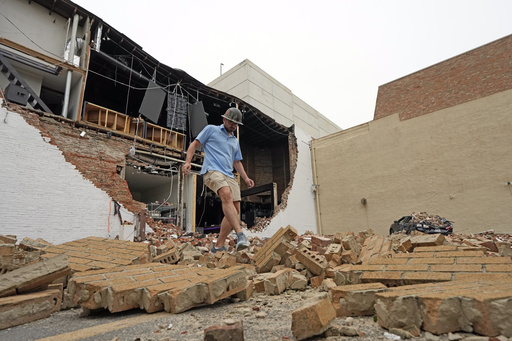Exceptional windstorms that could leave some Houston residents without power for weeks were a once-in-a-generation event and the damage left in their wake is comparable to that caused by a hurricane, meteorologists said Friday.
“We believe this windstorm is the most significant windstorm likely for the Houston area since Hurricane Alicia back in 1983,” said Janice Maldonado, a meteorologist at the National Weather Service Houston/Galveston office.
At least four people died after the storms barreled through Houston on Thursday. The fierce winds folded transmission towers, blew out windows and uprooted trees.
The National Weather Service on Friday confirmed one EF1 tornado touched down near the northwest Houston suburb of Cypress, and crews were investigating several other possible twisters in the area. Straight-line winds gusting over 80 mph in a single direction have been blamed for the damage, Maldonado said.
“The environment yesterday across southeast Texas was very favorable for these conditions,” said Maldonado, citing wind shear, a cold front and moisture in the atmosphere.
The storm was extreme even for Houstonians accustomed to powerful weather.
“I would say it’s … a generational wind event for Houston. I mean, you don’t see these types of things very often, unless of course, you’re in a hurricane or you have a tornado strike,” Northern Illinois University meteorology professor Victor Gensini said.
It was what meteorologists call a microburst, which is like “pouring pancake batter out onto a griddle … it hits the ground and then pushes out in all directions,” Gensini said.
Severe weather events raise questions about the role of a warming world. After all, most people experience climate change through shifts in their weather, according to Climate Central, a nonprofit with a team of scientists that research and analyze climate change. Extensive scientific research indicates that storms will become more intense, for example by dropping more rain, as the atmosphere warms and holds more water vapor.
The effect of climate change on thunderstorms is less clear than with other weather events, such as heat waves or hurricanes. Gensini explained this is because the storms are short-lived and cover relatively small distances.
“Imagine if you had a telescope, it would be relatively easy, depending on the power of your telescope, to see Jupiter. But if your telescope was the same power, you’re trying to pick out one of Jupiter’s moons, that’s a little bit more difficult,” he said.
___
The Associated Press’ climate and environmental coverage receives financial support from multiple private foundations. AP is solely responsible for all content. Find AP’s standards for working with philanthropies, a list of supporters and funded coverage areas at AP.org.
___
This story has been corrected to show the Houston suburb hit by a tornado is Cypress, not Cyprus.



